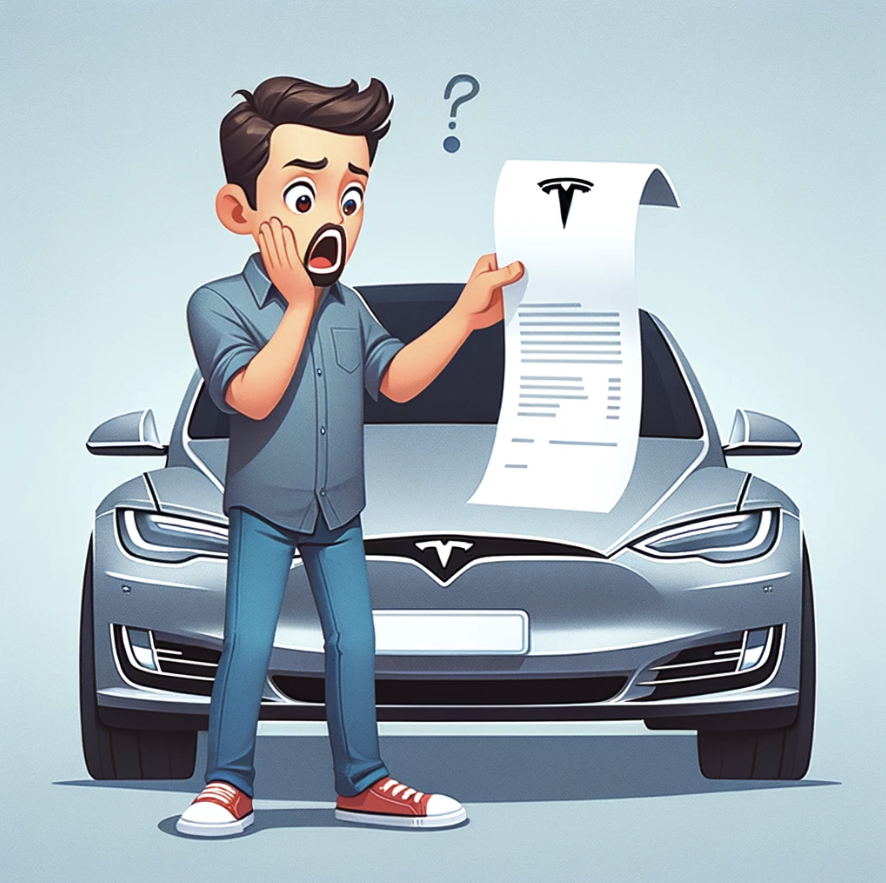We all hear about “saving on gas” with a Tesla or electric vehicle, but it’s not so simple.
Here’s a breakdown of some of the less obvious costs associated with owning a Tesla:
Table of Contents
Depreciation
- Rapid Pace: Teslas, like most luxury cars, tend to depreciate in value faster than their non-luxury counterparts. This means the resale value of your Tesla could be significantly lower a few years down the line.
- Technology Advancements: As Tesla frequently updates its software and car features, older models can become less desirable, impacting their value.
- Resale Value Considerations Beyond Depreciation: While depreciation is a significant factor, the resale value of a Tesla can also be influenced by updates to government incentives, changes in consumer demand for electric vehicles, and the introduction of new models or competitors.
Charging
- Home Charging Setup: While Teslas can often be charged at home, you might need to upgrade your electrical panel or install a dedicated 240-volt outlet for Level 2 charging, adding to initial costs.
- Public Charging: Using Superchargers or other public charging networks carries a cost, which can vary depending on location and network. While generally cheaper than gas, it’s still a recurring expense.
- Potential Peak Pricing: In some areas, electricity costs more during peak demand hours. If this coincides with your regular charging schedule, your charging costs can increase.
- Phantom Drain: Even when parked, Teslas can continue to use small amounts of battery power. In some circumstances, this can lead to an unexpectedly reduced range if the car is left for an extended period. Cold weather matters too. The company’s range claims have been found to be inflated.
Maintenance and Repairs
- Specialized Service: Teslas require specialized maintenance and repairs. Not every mechanic can service them, potentially leading to higher labor costs and a need to use Tesla-certified service centers.
- Parts Availability: Some Tesla parts might be less readily available than traditional car parts, leading to longer wait times and potentially higher repair costs.
- Limited Service Network: It’s worth noting that the limited number of Tesla service centers can also mean longer wait times for appointments, which could be an indirect cost in terms of time and convenience.
Battery
- Battery Replacement Costs: Over the long term, the battery in a Tesla may degrade and require replacement. While Tesla batteries are designed to last a long time, replacement costs can be significant if they fall outside of warranty coverage.
- Environmental Considerations: While not a direct cost, the environmental impact of producing and disposing of electric vehicle batteries is an important consideration. There are ongoing discussions about the life cycle environmental footprint of EVs compared to internal combustion engine vehicles.
Insurance
- Higher Premiums: Teslas can incur higher insurance premiums compared to some traditional vehicles due to their higher average repair costs and their status as luxury vehicles.
- Insurance Costs Variability: Insurance premiums can vary widely not just due to the vehicle’s luxury status but also because of the driver’s location, driving history, and how insurers assess the risk profile of electric vehicles. As the insurance market adjusts to the growing presence of EVs, these costs could fluctuate.
Tires
- Frequent Replacement: Due to Tesla’s powerful acceleration, tires may wear down faster than on a comparable non-electric car, leading to more frequent replacements.
Technology Upgrades
- Subscriptions: Some Tesla features, like Full Self-Driving (FSD) capability or certain enhanced Autopilot functions might require a paid subscription or a one-time purchase.
- Costly Updates: While Tesla frequently offers over-the-air software updates, certain major upgrades might be optional and carry a separate price tag.
- Software Dependency: The heavy reliance on software for vehicle functionality means that issues requiring software support or updates could potentially lead to costs or inconveniences not common with traditional vehicles.
Note: We do not recommend buying FSD, as it’s an ineffective L2 system that’s been deceptively marketed by the company and its CEO.
Important Considerations
- Incentives and savings: Factor in potential tax credits, rebates, and savings on fuel when considering the overall cost of owning a Tesla.
- Location: Some of the costs associated with Tesla ownership may vary depending on your location, local electricity pricing, and available charging infrastructure.
- Opportunity Costs: Choosing a Tesla over another vehicle could come with opportunity costs, including potential savings from other vehicles that might offer better incentives, lower insurance premiums, or different features that better suit individual needs.
Conclusion
Each of these factors contributes to the overall cost of ownership and might influence your decision-making process or satisfaction with a Tesla.
It’s always a good idea to conduct thorough research and consider all potential costs and benefits when considering a significant investment like an electric vehicle.


